For the 2025 school year, there are 3 public preschools serving 1,169 students in Marion 10 School District. This district's average pre testing ranking is 1/10, which is in the bottom 50% of public pre schools in South Carolina.
Public Preschools in Marion 10 School District have an average math proficiency score of 17% (versus the South Carolina public pre school average of 45%), and reading proficiency score of 21% (versus the 48% statewide average).
Minority enrollment is 84% of the student body (majority Black), which is more than the South Carolina public preschool average of 54% (majority Black).
Overview
This School District
This State (SC)
# Schools
10 Schools
578 Schools
# Students
3,808 Students
307,049 Students
# Teachers
239 Teachers
22,837 Teachers
Student : Teacher Ratio
17:1
17:1
District Rank
Marion 10 School District, which is ranked within the bottom 50% of all 76 school districts in South Carolina (based off of combined math and reading proficiency testing data) for the 2021-2022 school year.
The school district's graduation rate of 80% has decreased from 86% over five school years.
Overall District Rank
#77 out of 81 school districts
(Bottom 50%)
(Bottom 50%)
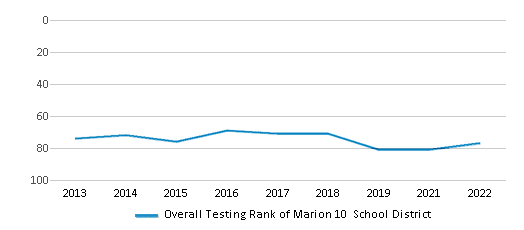
Math Test Scores (% Proficient)
16%
41%
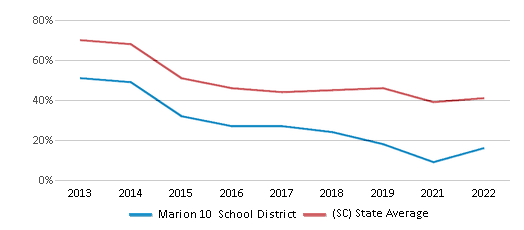
Reading/Language Arts Test Scores (% Proficient)
27%
52%
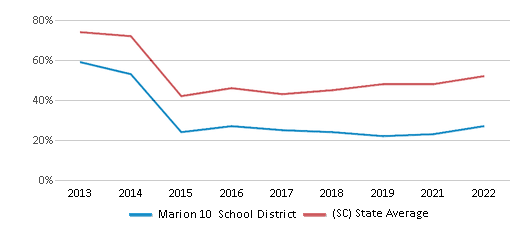
Science Test Scores (% Proficient)
24%
50%
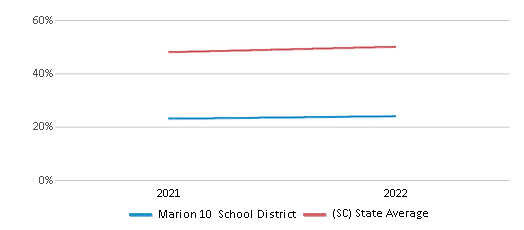
Graduation Rate
80%
84%
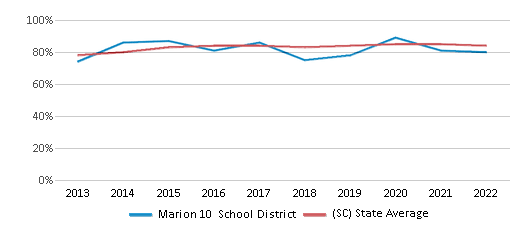
Students by Ethnicity:
Diversity Score
0.40
0.67
# American Indian Students
18 Students
905 Students
% American Indian Students
n/a
n/a
# Asian Students
12 Students
4,942 Students
% Asian Students
n/a
1%
# Hispanic Students
179 Students
41,883 Students
% Hispanic Students
5%
14%
# Black Students
2,891 Students
97,124 Students
% Black Students
76%
32%
# White Students
561 Students
140,483 Students
% White Students
15%
46%
# Hawaiian Students
n/a
402 Students
% Hawaiian Students
n/a
n/a
# Two or more races Students
147 Students
21,254 Students
% of Two or more races Students
4%
7%
Students by Grade:
# Students in PK Grade:
133
27,258
# Students in K Grade:
267
46,285
# Students in 1st Grade:
272
47,365
# Students in 2nd Grade:
266
48,243
# Students in 3rd Grade:
295
43,895
# Students in 4th Grade:
271
43,663
# Students in 5th Grade:
269
40,854
# Students in 6th Grade:
271
3,355
# Students in 7th Grade:
292
2,477
# Students in 8th Grade:
307
2,190
# Students in 9th Grade:
362
439
# Students in 10th Grade:
287
373
# Students in 11th Grade:
254
325
# Students in 12th Grade:
262
327
# Ungraded Students:
-
-
District Revenue and Spending
The revenue/student of $14,471 in this school district is less than the state median of $15,220. The school district revenue/student has grown by 8% over four school years.
The school district's spending/student of $13,950 is less than the state median of $14,817. The school district spending/student has grown by 8% over four school years.
Total Revenue
$55 MM
$12,084 MM

Spending
$53 MM
$11,764 MM
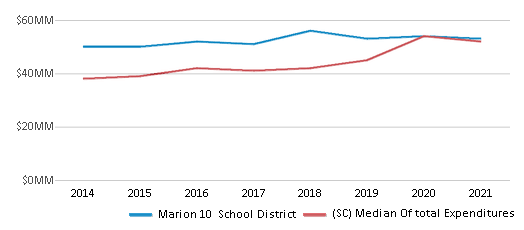
Revenue / Student
$14,471
$15,220
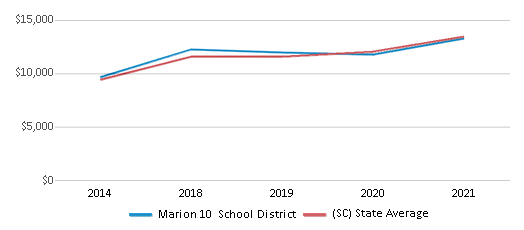
Spending / Student
$13,950
$14,817
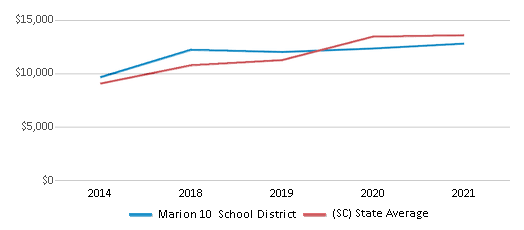
Best Marion 10 School District Public Preschools (2025)
School
(Math and Reading Proficiency)
(Math and Reading Proficiency)
Location
Grades
Students
Rank: #11.
Creek Bridge Stem Academy
(Math: 17% | Reading: 21%)
Rank:
Rank:
1/
Bottom 50%10
6641 South Highway 41
Marion, SC 29571
(843) 362-3500
Marion, SC 29571
(843) 362-3500
Grades: PK-8
| 345 students
Rank: n/an/a
600 East Northside Avenue
Marion, SC 29571
(843) 423-8335
Marion, SC 29571
(843) 423-8335
Grades: PK-2
| 453 students
Rank: n/an/a
105 Charles Street
Mullins, SC 29574
(843) 464-3750
Mullins, SC 29574
(843) 464-3750
Grades: PK-2
| 371 students
Recent Articles

Year-Round Or Traditional Schedule?
Which is more appropriate for your child? A year-round attendance schedule or traditional schedule? We look at the pros and cons.

Why You Should Encourage Your Child to Join a Sports Team
Participating in team sports has a great many benefits for children, there is no doubt. In this article you will learn what those benefits are.

White Students are Now the Minority in U.S. Public Schools
Increasing birth rates among immigrant families from Asia and Central and South America, combined with lower birth rates among white families, means that for the first time in history, public school students in the United States are majority-minority. This shift in demographics poses difficulties for schools as they work to accommodate children of varying language abilities and socio-economic backgrounds.





